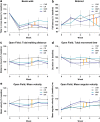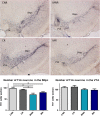Physical Exercise Modulates L-DOPA-Regulated Molecular Pathways in the MPTP Mouse Model of Parkinson's Disease
- PMID: 29019056
- PMCID: PMC5994219
- DOI: 10.1007/s12035-017-0775-0
Physical Exercise Modulates L-DOPA-Regulated Molecular Pathways in the MPTP Mouse Model of Parkinson's Disease
Abstract
Parkinson's disease (PD) is characterized by the degeneration of dopaminergic (DA) neurons in the substantia nigra pars compacta (SNpc), resulting in motor and non-motor dysfunction. Physical exercise improves these symptoms in PD patients. To explore the molecular mechanisms underlying the beneficial effects of physical exercise, we exposed 1-methyl-4-phenyl-1,2,3,6-tetrahydropyrimidine (MPTP)-treated mice to a four-week physical exercise regimen, and subsequently explored their motor performance and the transcriptome of multiple PD-linked brain areas. MPTP reduced the number of DA neurons in the SNpc, whereas physical exercise improved beam walking, rotarod performance, and motor behavior in the open field. Further, enrichment analyses of the RNA-sequencing data revealed that in the MPTP-treated mice physical exercise predominantly modulated signaling cascades that are regulated by the top upstream regulators L-DOPA, RICTOR, CREB1, or bicuculline/dalfampridine, associated with movement disorders, mitochondrial dysfunction, and epilepsy-related processes. To elucidate the molecular pathways underlying these cascades, we integrated the proteins encoded by the exercise-induced differentially expressed mRNAs for each of the upstream regulators into a molecular landscape, for multiple key brain areas. Most notable was the opposite effect of physical exercise compared to previously reported effects of L-DOPA on the expression of mRNAs in the SN and the ventromedial striatum that are involved in-among other processes-circadian rhythm and signaling involving DA, neuropeptides, and endocannabinoids. Altogether, our findings suggest that physical exercise can improve motor function in PD and may, at the same time, counteract L-DOPA-mediated molecular mechanisms. Further, we hypothesize that physical exercise has the potential to improve non-motor symptoms of PD, some of which may be the result of (chronic) L-DOPA use.
Keywords: (Non-)motor function; L-DOPA; MPTP; Molecular landscape; Parkinson’s disease; Physical exercise.
Conflict of interest statement
Conflict of Interest
The authors declare that they have no conflict of interest.
Figures






Similar articles
-
Social enrichment attenuates nigrostriatal lesioning and reverses motor impairment in a progressive 1-methyl-2-phenyl-1,2,3,6-tetrahydropyridine (MPTP) mouse model of Parkinson's disease.Neurobiol Dis. 2012 Mar;45(3):1051-67. doi: 10.1016/j.nbd.2011.12.024. Epub 2011 Dec 14. Neurobiol Dis. 2012. PMID: 22198503
-
Exercise in an animal model of Parkinson's disease: Motor recovery but not restoration of the nigrostriatal pathway.Neuroscience. 2017 Sep 17;359:224-247. doi: 10.1016/j.neuroscience.2017.07.031. Epub 2017 Jul 25. Neuroscience. 2017. PMID: 28754312
-
Combining nitric oxide release with anti-inflammatory activity preserves nigrostriatal dopaminergic innervation and prevents motor impairment in a 1-methyl-4-phenyl-1,2,3,6-tetrahydropyridine model of Parkinson's disease.J Neuroinflammation. 2010 Nov 23;7:83. doi: 10.1186/1742-2094-7-83. J Neuroinflammation. 2010. PMID: 21092260 Free PMC article.
-
RGS Proteins as Critical Regulators of Motor Function and Their Implications in Parkinson's Disease.Mol Pharmacol. 2020 Dec;98(6):730-738. doi: 10.1124/mol.119.118836. Epub 2020 Feb 3. Mol Pharmacol. 2020. PMID: 32015009 Free PMC article. Review.
-
Voluntary exercise delays progressive deterioration of markers of metabolism and behavior in a mouse model of Parkinson's disease.Brain Res. 2019 Oct 1;1720:146301. doi: 10.1016/j.brainres.2019.146301. Epub 2019 Jun 18. Brain Res. 2019. PMID: 31226324 Free PMC article. Review.
Cited by
-
Multi-omics studies reveal ameliorating effects of physical exercise on neurodegenerative diseases.Front Aging Neurosci. 2022 Oct 31;14:1026688. doi: 10.3389/fnagi.2022.1026688. eCollection 2022. Front Aging Neurosci. 2022. PMID: 36389059 Free PMC article. Review.
-
The potassium channel KCa3.1 represents a valid pharmacological target for microgliosis-induced neuronal impairment in a mouse model of Parkinson's disease.J Neuroinflammation. 2019 Dec 26;16(1):273. doi: 10.1186/s12974-019-1682-2. J Neuroinflammation. 2019. PMID: 31878950 Free PMC article.
-
Physical activity and lifestyle modifications in the treatment of neurodegenerative diseases.Front Aging Neurosci. 2023 May 26;15:1185671. doi: 10.3389/fnagi.2023.1185671. eCollection 2023. Front Aging Neurosci. 2023. PMID: 37304072 Free PMC article. Review.
-
Tumor Necrosis Factor-Like Weak Inducer of Apoptosis (TWEAK) Enhances Activation of STAT3/NLRC4 Inflammasome Signaling Axis through PKCδ in Astrocytes: Implications for Parkinson's Disease.Cells. 2020 Aug 4;9(8):1831. doi: 10.3390/cells9081831. Cells. 2020. PMID: 32759670 Free PMC article.
-
Treadmill Exercise Attenuates L-DOPA-Induced Dyskinesia and Increases Striatal Levels of Glial Cell-Derived Neurotrophic Factor (GDNF) in Hemiparkinsonian Mice.Mol Neurobiol. 2019 Apr;56(4):2944-2951. doi: 10.1007/s12035-018-1278-3. Epub 2018 Aug 2. Mol Neurobiol. 2019. PMID: 30073506
References
-
- Goetz CG, Tilley BC, Shaftman SR, Stebbins GT, Fahn S, Martinez-Martin P, et al. Movement Disorder Society-sponsored revision of the Unified Parkinson's Disease Rating Scale (MDS-UPDRS): scale presentation and clinimetric testing results. Mov Disord. 2008;23(15):2129–2170. - PubMed
-
- Sveinbjornsdottir S. The clinical symptoms of Parkinson's disease. J Neurochem. 2016;139(Suppl 1):318–324. - PubMed
-
- Cotzias GC, Van Woert MH, Schiffer LM. Aromatic amino acids and modification of parkinsonism. N Engl J Med. 1967;276(7):374–379. - PubMed
-
- Fox SH, Katzenschlager R, Lim SY, Ravina B, Seppi K, Coelho M, et al. The Movement Disorder Society evidence-based medicine review update: treatments for the motor symptoms of Parkinson's disease. Mov Disord. 2011;26(Suppl 3):S2–41. - PubMed
MeSH terms
Substances
Grants and funding
LinkOut - more resources
Full Text Sources
Other Literature Sources
Medical
Miscellaneous

